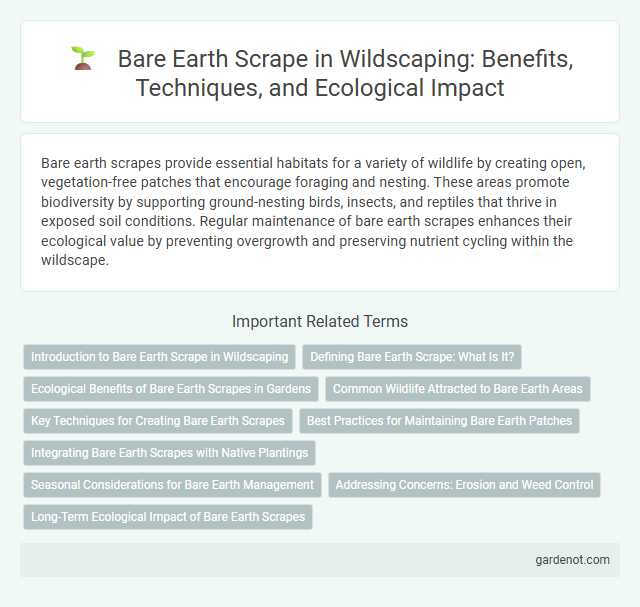Bare earth scrapes provide essential habitats for a variety of wildlife by creating open, vegetation-free patches that encourage foraging and nesting. These areas promote biodiversity by supporting ground-nesting birds, insects, and reptiles that thrive in exposed soil conditions. Regular maintenance of bare earth scrapes enhances their ecological value by preventing overgrowth and preserving nutrient cycling within the wildscape.
Introduction to Bare Earth Scrape in Wildscaping
Bare earth scrape in wildscaping involves removing vegetation and topsoil to create open, bare ground patches that mimic natural disturbances, promoting biodiversity by providing habitat for ground-nesting birds, insects, and specialized plants. These scrapes improve soil exposure, enhance seed germination, and support species that thrive in early successional environments, contributing to a dynamic ecosystem. Integrating bare earth scrapes into wildscape designs increases habitat heterogeneity and fosters resilience in native wildlife populations.
Defining Bare Earth Scrape: What Is It?
A bare earth scrape is a purposely cleared area where topsoil and vegetation are removed to expose the underlying soil, creating ideal conditions for ground-nesting birds and other wildlife. This habitat modification encourages the growth of pioneer plants, which provide essential food and shelter for diverse species. Bare earth scrapes are critical for promoting biodiversity and supporting species that rely on open, sparsely vegetated environments.
Ecological Benefits of Bare Earth Scrapes in Gardens
Bare earth scrapes in gardens create essential microhabitats that support ground-nesting birds, amphibians, and invertebrates by providing exposed soil for foraging and breeding. These patches enhance biodiversity by encouraging native plant colonization and increasing soil microbial activity, which improves nutrient cycling. Incorporating bare earth scrapes contributes to restoring ecological balance and promotes a thriving, functional garden ecosystem.
Common Wildlife Attracted to Bare Earth Areas
Bare earth scrapes create ideal habitats that attract diverse wildlife such as ground-nesting birds, small mammals, and insects. Species like robins, sparrows, lizards, and various pollinators are frequently observed foraging and nesting in these open, bare soil patches. These areas provide essential resources like exposed soil for nesting, increased insect availability, and easy access to minerals, supporting the ecological balance within a wildscape.
Key Techniques for Creating Bare Earth Scrapes
Key techniques for creating bare earth scrapes include careful site selection to ensure optimal soil type and drainage, followed by mechanical removal of vegetation using graders or excavators to expose underlying soil. Maintaining appropriate scrape depth, typically between 10 to 30 centimeters, promotes suitable microhabitats for invertebrates and ground-nesting birds. Regular monitoring and periodic re-scraping prevent vegetation encroachment and sustain the ecological benefits of bare earth scrapes within wildscape conservation efforts.
Best Practices for Maintaining Bare Earth Patches
Maintaining bare earth patches in wildscape areas requires regular monitoring to prevent erosion and invasive plant encroachment. Employing controlled scraping techniques ensures soil structure is preserved while fostering habitats for specialized flora and fauna. Integrating seasonal assessments and minimal disturbance practices enhances the ecological value and sustainability of these bare earth zones.
Integrating Bare Earth Scrapes with Native Plantings
Integrating bare earth scrapes with native plantings enhances habitat restoration by promoting soil stability and supporting local biodiversity. These scrapes create microhabitats that encourage the establishment of native grasses, wildflowers, and shrubs, which are essential for pollinators and ground-nesting wildlife. Effective design incorporates soil texture and moisture retention to optimize native plant growth and sustain ecological balance within the wildscape.
Seasonal Considerations for Bare Earth Management
Bare earth scrape management must account for seasonal variations to optimize soil exposure and vegetation control. Conducting scrapes during late autumn or early winter minimizes disturbance to breeding wildlife and promotes natural seed germination in spring. Timing these activities around climatic patterns reduces erosion risk and enhances habitat restoration efficacy in Wildscape settings.
Addressing Concerns: Erosion and Weed Control
Bare earth scrapes in wildscape design effectively manage soil erosion by exposing mineral soil, promoting native seed germination and establishing stable vegetation cover. Strategic scraping reduces weed proliferation by removing invasive species seeds and root systems, thereby enhancing biodiversity and ecosystem health. Implementing controlled bare earth areas supports sustainable habitat restoration and long-term landscape resilience.
Long-Term Ecological Impact of Bare Earth Scrapes
Bare earth scrapes create unique microhabitats that support early successional species, promoting biodiversity by providing nesting and foraging sites for ground-nesting birds and invertebrates. Over time, these scrapes facilitate soil regeneration and vegetation succession, enhancing habitat heterogeneity within the wildscape ecosystem. Monitoring long-term ecological impacts reveals increased species richness and improved structural diversity crucial for sustaining resilient wildlife populations.
Bare earth scrape Infographic

 gardenot.com
gardenot.com